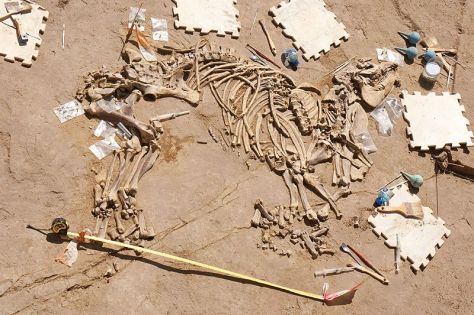NewsNext Previous
Found in the Camp dels Ninots a whole new tapir skeleton 3.1 million years ago and in anatomical connection
This finding the site Caldes de Malavella concentrates and 70% of global fossil record of this species
It is a very important discovery because it will help you get plenty of information on the ecological environment was at that time
The excavation that this May is developed on the site of Camp dels Ninots in Caldes de Malavella (Girona, Catalonia), under the direction of IPHES (Institut Català de Paleoecologia Humana i Evolució Social), has discovered the entire skeleton of a tapir than three million years, also is in anatomical connection. With the finding the Camp dels Ninots concentrates and 70% of the fossil record of this species.
“While in Europe there are many other isolated sites with remains of tapir, Camp dels Ninots is the only one who keeps whole and in anatomical connection in an exceptional state”, they said Bruno Gomez and Gerard Campeny, researchers IPHES and codirectors of this project. The measures of tapir that has appeared these days would be for a young of about 1.80 m long and 1.30 m high, which should weigh about 250 kilograms and belonged to the species Tapirus arvernensis.

3.1 million years ago tapirs were abundant in the Mediterranean, at a time when governing a subtropical climate, wetter than today, with relatively mild temperatures, abundant rainfall and low seasonality. One of the characteristics of the vegetation of Western Europe at that time was that it was characterized by forests of laurel (laurel) evergreen as those currently found in southeast China and the Mississippi Delta, dominated, for example, called cypress swamps.
Reconstruction of the landscape
At the site of Camp dels Ninots had been able to reconstruct the landscape of this area thanks to the abundant traces of plant remains, mainly leaves and fruit, which have been trapped in its sediments. Their study has allowed distinguish the existence of aquatic vegetation, submerged plants living in shallow and shallow. Another documented vegetation is typical of forest laugh with poplars, willows, etc. and finally, where we find a laurisilva, oak, holly and some deciduous trees such as walnut.
It is in this environmental context where tapirs found ideal conditions for living. These animals are mammals too bulky to base their feeding on leaves and fruits, which in this environment could have during the whole year. The presence of the waters of ancient Lake Camp dels Ninots provided enough food not only shelter but also the possible attacks of carnivores in the area.
With the skeleton of a tapir located this year, along with the other four previous excavations, all of different ages, it is shown that the environment of Camp dels Ninots was right to live a stable population of this animal so extraordinary. Their extinction in Europe in the early Pleistocene, between 2.8 and 2.5 million years is a result of climate change run by the cyclicity of the glacial and interglacial periods, when the subtropical landscape was replaced by Mediterranean-type vegetation.
Currently, the tapirs are found in very specific areas of Central America and Asia, especially China and Sumatra. The Tapirus indicus, black and white fur, is more closely related living species that lived in Camp dels Ninots.
The site Camp dels Ninots is included in the four-year research project “El Plio-pleistocè del Camp dels Ninots i la depressió prelitoral: evolució paleoclimàtica, dispersions faunístiques i humanes” (2014/100575) promote by the Departament de Cultura de la Generalitat de Catalunya.


